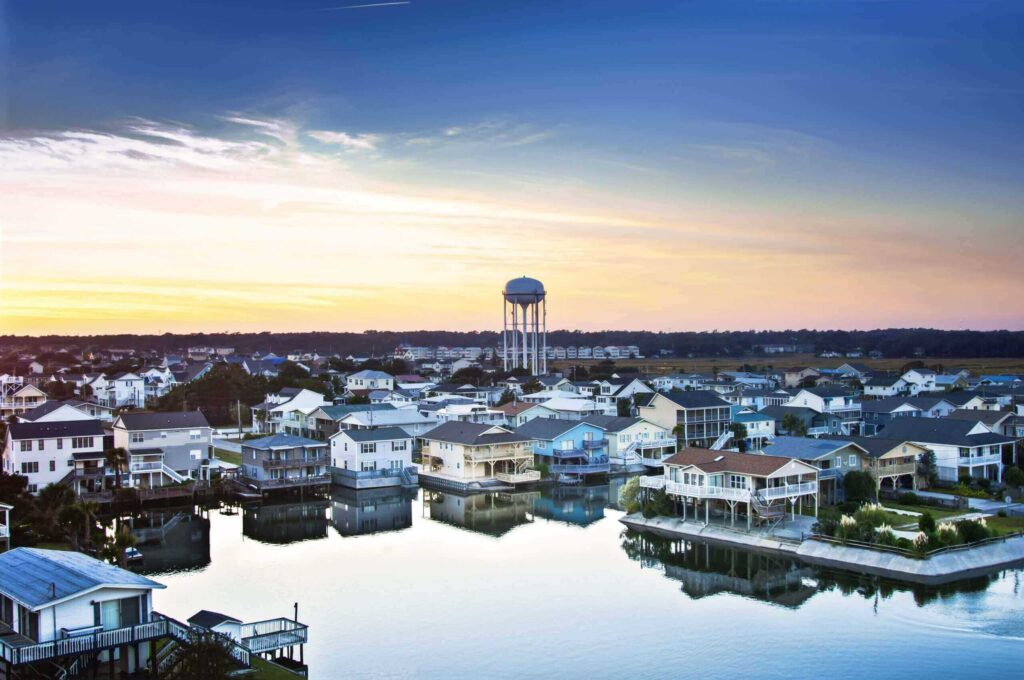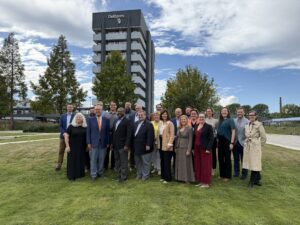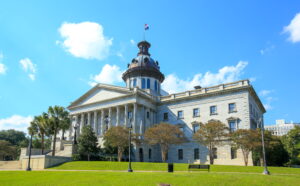May 21, 2021
—
Updated February 10, 2022: The Department of the Treasury recently released the final rule governing eligible uses for $350 billion in Coronavirus State and Local Fiscal Recovery Funds established by the American Rescue Plan (ARP). Read on to learn more about the ARP and how communities can use these funds to build resilience.
—
In March 2021, Congress passed the American Rescue Plan (ARP). This $1.9 trillion law builds on three previous COVID-19 relief packages already enacted by the previous Congress throughout 2020.
As our national recovery from COVID-19 continues, leaders must build back with additional risks posed by rising seas, stronger storms, and more frequent flooding in mind. Delivering the most significant influx of federal funding in decades, ARP resources can help communities recover with greater resilience today and fund once-in-a-generation projects for a stronger future. That includes providing funds for communities to boost resilience and prepare for floods and other disasters.
Although the pandemic has affected the entire nation, it has disproportionately harmed low-income families and communities of color and exacerbated systemic health and economic inequities. ARP resources, therefore, should be deployed in ways that increase equity in disaster recovery and local leaders must engage constituents and communities on how funding should be spent.
While ARP invests in a wide range of programs, this blog focuses on how state and local communities can use part of its funding to invest in resilience. After a record-breaking hurricane season in 2020, unlocking this flexible financial assistance, which can be deployed for transformative investments in resilience, is critical for state, local, tribal, and territory governments.
Across the country, we are seeing governors, state legislators, mayors, and city managers rolling up their sleeves to leverage ARP funding for flood resilient infrastructure along with other top priorities. As jurisdictions at various levels plan to deploy funding, stakeholders should consult with one another on ways to best leverage resources for the greatest possible good. For example:
- Florida’s state budget directed $500 million of ARP funding to its newly created Resilient Florida Trust Fund, part of a new landmark state law dedicated to addressing flooding and sea level rise. Mayors in Cape Coral and Fort Myer are also targeting infrastructure for their cities’ funding allocations.
- South Carolina Gov. Henry McMaster, an AFC member, will work with the state legislature to allocate the state’s ARP funds, including for priority sewer and water projects.
Finally, as Congress contemplates legislation to address infrastructure nationwide, ARP resources will form an important foundation for a shared, equitable recovery. As leaders allocate ARP dollars to immediate needs, they can also assess resilience and flooding priorities, review project budgets and timelines, and prepare for additional federal infrastructure funding that could arrive later this year.
Simply put, ARP funding presents a monumental opportunity for resilience and flood reduction. AFC members and other local entities should refer to this high-level (but by no means exhaustive) overview to better understand how to use select ARP resources to rebuild from the pandemic while preparing for future flood risks.
ARP Coronavirus State and Local Recovery Funding Overview
The following sections summarize key aspects of ARP guidance released by the Treasury. The Treasury’s final rule was published in the Federal Register on January 6, 2022. Details in this blog are effective February 10, 2022. Importantly, AFC urges those that receive funds to ensure compliance with the law by deferring to the Treasury’s full suite of resources as well as any forthcoming updates.
Separate from other resources appropriated by Congress for various federal agencies, ARP’s Treasury-administered Coronavirus State and Local Recovery Funds can be spent on supporting the public health response; addressing the pandemic’s disproportionate public health and economic impacts on hardest-hit communities and households including by fostering healthy childhood environments; rebuilding public sector capacity including premium (hazard) pay for essential government workers; and funding government services and replenishing lost public revenue for purposes such as:
- Maintenance of existing infrastructure or building of new infrastructure, including roads
- Cybersecurity modernization, including hardware, software, and other critical infrastructure protection
- Health services
- Environmental remediation
- School or educational services
- Police, fire, first responders, and other public safety services
ARP State and Local Recovery funding can also support households, small businesses, nonprofits, and other industries greatly affected by COVID-19, such as tourism, travel, and hospitality. Finally, funding can be deployed for necessary investments in water, sewer, or broadband infrastructure.
Across these broad purposes, recipients must demonstrate that funding is deployed in response to health or economic harm from the pandemic and is allocated in a “related and reasonably proportional” manner.
How could this funding support resilience?
Investments in water and sewer infrastructure present a variety of opportunities to boost resilience. Treasury guidance specifically references improving access to clean drinking water and supporting vital wastewater and stormwater infrastructure, but also provides “wide latitude” for local entities to identify the top water and sewer infrastructure priorities within their own communities. Examples include:
- Investing in publicly owned treatment infrastructure, including building or upgrading water and sewer facilities
- Managing and treating stormwater or subsurface drainage water
- Facilitating water reuse
- Securing publicly-owned treatment works
- Building or upgrading transmission, distribution, and storage systems
Water and sewer infrastructure projects may align with broad eligibility criteria associated with projects funded through the Environmental Protection Agency’s Clean Water State Revolving Fund and Drinking Water State Revolving Fund, and can also include culvert improvements and removal, replacement of storm sewers, and stormwater infrastructure. Entities are encouraged to consider investing in green infrastructure, including projects that increase resilience to more frequent and extreme precipitation and related consequences, such as stormwater runoff, water pollution, and flooding.
By using ARP funds to replenish public revenue, entities can also enhance resilience through government services including building, maintaining, or hardening infrastructure to better prepare for flooding and other disasters; completing environmental remediation; or investing in public safety and emergency response services that build resilience to future disasters.
Finally, ARP funds that address COVID-19’s disproportionate public health and economic impacts on hardest-hit populations could be invested in more resilient housing, schools, or water and sanitation systems, or address other acute needs within designated qualified census tracts.
Importantly, ARP dollars cannot be used for “general” infrastructure spending outside of water, sewer, and broadband investments, or for purposes under the lost revenue or hardest-hit community provisions identified above.
When does funding expire?
ARP funding is generally available for costs incurred between March 3, 2021 and December 31, 2024. As infrastructure projects are often lengthy and multi-phased, Coronavirus State and Local Recovery Funds funds can be spent through the end of 2026, so long as they are obligated for a particular purpose by December 31, 2024.
What is the compliance process?
To receive funds, eligible state, territorial, metropolitan city, county, and tribal governments must submit a request to the Treasury. Municipalities, however, should not request funds via the Treasury; they will receive funds from their applicable state government. More information for municipalities is at the Treasury’s website.
States, territories, metropolitan cities, counties, and tribal governments were required to submit interim reports on their use of funds by August 31, 2021, followed by quarterly project and expenditure reports through December 31, 2026.
Local governments with populations of less than 50,000 are not required to submit interim reports but were required to submit quarterly project and expenditure reports by October 31, 2021, followed by annual reports.
Additional reporting requirements for various entities are outlined in the Treasury’s final rule (page 110).
How much funding is available, and how is it being divided up?
The ARP’s Coronavirus State and Local Recovery Funding provides $350 billion overall, including:
$195.3 billion for states
- $25.5 billion is split evenly among each state and Washington, D.C., so that each receives $500 million
- $168.55 billion is divided based on each state’s share of total unemployed workers from October–December 2020
- States that experienced a net increase of more than 2% in unemployment between February 2020 and the most recent available data will receive funds in a single payment; otherwise, states will receive the first half of their allocated funds in spring 2021, followed by a second installment approximately one year later
$65.1 billion for counties
- Counties will receive population-adjusted payments based on their share of the U.S. population, with additional adjustments for Community Development Block Grant recipients
- Local governments will receive funds in two payments, with half provided in spring 2021, and the second half delivered one year later
$45.6 billion for metropolitan cities
- Metropolitan cities will receive funds in two payments, with half provided in spring 2021, and the second half delivered one year later
$20 billion for tribal governments
- $1 billion is split equally among tribal governments, and $19 billion is divided by the Treasury Secretary based on enrollment and employment data
- Tribal governments will receive two payments, with the first payment in spring 2021, and the second (based on employment data) to follow in summer 2021
$19.5 billion for local government with populations of less than 50,000
- States will distribute population-adjusted payments to these jurisdictions within 30 days of receipt
- Payments cannot exceed 75% of the jurisdiction’s most recent budget (as of Jan. 27, 2020). Funds that exceed this cap must be returned to the Treasury
$4.5 billion for territorial governments
- 50% is evenly split across territories
- U.S. territories will receive full funding as a single payment
How can I learn more?
For more information on funding featured in this blog, see the Treasury’s full suite of guidance, including its Final Rule, FAQs, and Fact Sheet.
To learn more about other ARP investments, check out Drexel University’s Nowak Metro Finance Lab ARP federal investment guide, as well as the National League of Cities’ estimated allocation tool.
We also encourage members to revisit AFC resources such as our Flood Funding Finder and Adaptation for All Guide, both of which help local leaders determine approaches to flooding and sea level rise that work best for them.
Additionally, the following sites have specific resources for investments from the Inflation Reduction Act: Drexel University’s Nowak Metro Finance Lab ARP federal investment guide, the National League of Cities’ estimated allocation tool, and the National Conference of State Legislatures’ ARP State Fiscal Recovery Fund Allocations Dashboard.






